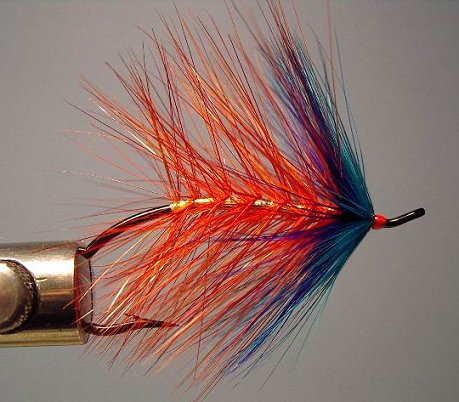
On The Fly
December 2012
"Fly tying is a school from which we never graduate"
TYING NEWS
The Southern Oregon Fly Tyers invite you to attend their meetings the second Tuesday of
each month. The next meeting is December 19, 2012. The meetings start at 6:00 PM, at the Madrone Hill
Mobile Home Park community building near Gold Hill. Bring a friend, come early so you don't miss
anything, and stay late. Tyers need not be experienced, and those with all levels of skill are
welcome. Each meeting a member is encouraged to demonstrate a new or different skill, from simple
to difficult. For more information, call Dan Kellogg at 773-4724.
DIRECTIONS: Take Gold Hill Exit #40, off of I-5 and go west, toward Jacksonville, 1.3 miles, until you
reach the brick entrance way to the Madrone Hill Mobile Home Park on the right. You’ll pass a golf course
parking lot on your left shortly after leaving the freeway. After you turn right into the
mobile home park, proceed to the community building which is located about 100 yards ahead on the left. The
address is 8401 Old Stage Rd. Please park your vehicle on the bare dirt in the parking lot to avoid the
wooden septic covers in the grass
 PATTERN OF THE MONTH –Paint Brush
PATTERN OF THE MONTH –Paint Brush
Hook: Daiichi 2161, Curved shank salmon/steelhead, 1-6.
Thread: 6-0 red.
Body: Wide gold flat tinsel
Body Hackle: Red-orange hackle palmered over tinsel.
Hackle: Purple, veiled by turquoise blue.
Tying Instructions:
Step 1: Mash the barb, mount the hook in the vise, start the thread behind the hook eye, and lay down a
smooth thread base to a point just above the hook point.
Step 2: Select a hot orange hackle feather with barbs at the tip end a bit longer than the hook gape.
Prepare the feather and tie in by the tip, just above the hook point, with the shiny side facing you. The
tip of the feather should be pointed toward the hook eye and the rest hanging over the back of the hook.
Step 3: Advance the thread in smooth spiral wraps forward to the starting point. Tie in the flat tinsel
making sure that when you start your turns, the gold side is up. Wrap the tinsel in touching turns rearward
to the end of the thread base, then reverse directions and wrap forward to the tie in point. Tie off and
clip the excess.
Step 4: Lift the hot orange feather and fold the barbs to the rear. Wrap the hackle forward over the tinsel
body in 5 equally spaced spiral turns to the front of the body. Tie off and clip the excess.
Step 5: Select a purple hackle feather with barb a bit longer than the body hackle. Prepare and tie in by
the tip, shiny side facing you, fold the barbs rearward and take two turn while stroking the barbs rearward
on each half turn. Tie off and trim excess.
Step 6: Select a blue hackle feather with barbs a bit shorter than the purple feather. Tie in and wind two
turns using the same method as step 5. Tie off and trim.
Step 7: Tie back slightly on the blue and purple hackle forcing the rearward at a slight angle. Form a neat
tapered thread head, whip finish and cement.
The Paint Brush is one of Bill McMillan's signature flies along with his Winter's Hope
and the Steelhead Caddis. The fly was developed in 1973 and has proven itself as a very productive Winter
Steelhead pattern. It's an elegant creation using only two materials, tinsel and hackle. In his words
McMillan says " I always prefer simple patterns that use a minimum of materials because: 1) they sink
better: 2) I am a very slow tier; 3) I don't like to pretend that a fish is more complicated that the
rather primitive animal it is; and 4) intricate fly patterns are for the human mind, not the fish's."
Its basic shape is reminiscent of Stewart's Spiders and old time wet flies. The Paint Bruch is tied with
the hackles gradually tapering longer toward the hook eye, and uses hackles that are soft and very webby.
It is best dressed on heavier irons and fished using a floating line and strictly on a deep natural drift.
McMillan named the fly for its resemblance to the Indian Paintbrush mountain flower.
Bill Mcmillan believes that being a celebrated fly fisherman is his life's work. He is
not only a great and innovative steelhead angler, but has created flies that are an important part of
Northwest steelheading tradition. He has also written a classic fly fishing book and is one of the sport's
most passionate and articulate advocates for wild fish. In recent years, Bill's work has been focused on
ensuring the survival of wild steelhead and other native Pacific Northwest fish.
A Final Note
This will be my last installment to the "On The Fly" newsletter column. I have greatly
enjoyed writing about the numerous fly patterns and techniques that I find interesting, and hope that these
monthly mini-classes over the last 8 years have inspired a continued interest in the unending lessons to be
learned about fly tying. My friend, Dave Roberts has agreed to continue the column. He's a great writer and
a "bottomless pit" of fly tying lore and knowledge. So tie some up, give them a test flight and let me know
how you do.
Tie One On,
Dan Kellogg
(you can contact me at FLYGUY@EZNORTHWEST.COM)
www.tyerstoolshop.com